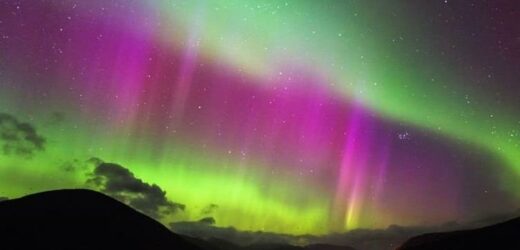Northern Lights captured by ISS 250 miles above Earth
We use your sign-up to provide content in ways you’ve consented to and to improve our understanding of you. This may include adverts from us and 3rd parties based on our understanding. You can unsubscribe at any time. More info
A solar flare has erupted and is expected to reach the Earth on Saturday – triggering the stunningly beautiful Aurora Borealis across parts of the globe. Also known as the Northern Lights, these may be accompanied by a strong solar-magnetic storm which the National Oceanic and Atmospheric Administration (NOAA) has issued a warning for.
The Northern Lights can be seen across the skies when massive levels of charged particles explode from the sun and come into contact with the Earth’s magnetic field.
These then react with gas molecules, giving off energy which creates the vibrant lights in the sky associated with the Northern Lights.
Often Aurora Borealis can be seen across Norway and Iceland between late September and early March each year, however, solar events can bring them to other parts of the world – including the UK.
So how can you watch the Northern Lights and will they be visible in the UK tonight?
Read More: Solar storm warning: Get ready! NASA forecasts ‘significant’ flare


The Northern Lights are attracted to magnetic poles in both the Northern and Southern Hemispheres and so when visible in the UK they can be seen in the northern-most part of the UK – Scotland.
However this weekend the lights will be visible further south than usual.
Those in mid-Wales, the Midlands and parts of the East of England may be able to witness the spectacle on Saturday evening – when the Aurora reaches its peak.
Weather forecasts are for clear skies for at least the first half of the evening, so sky gazers may be able to view the spectacle tonight.

The Met Office has the following tips for seeing the Northern Lights
- You need a clear night with no cloud cover
- Find a dark location with no light pollution
- Look toward the northern horizon
- Be cautious that geomagnetic activity can cause disturbances to satellite navigation (GNSS/GPS etc)
DON’T MISS
Space breakthrough as discovery on Venus questions planet’s ‘death’ [INSIGHT]
Solar storm fears: National Grid warned after flare batters Earth [ANALYSIS]
UK weather forecast: Britain to be blasted by eight inches of snow [FORECAST]

For other parts of the world the lights will be visible
- Dublin, Ireland
- Hamburg, Germany
- St. Petersburg, Russia
- Norway
- Sweden
- Finland
USA
- Portland, Oregon to New York City
- Carson City, Nevada
- Oklahoma City
- Raleigh, North Carolina
Despite the beauty of the Aurora Borealis, it can also cause disruption.
NOAA’s warning cautions of issues to
Power Systems
– Voltage irregularities; false alarms on some protection devices
Spacecraft
– Surface changing; orientation problems; increased drag on low-Earth orbiters
Radio and Navigation
– Intermittent HF propagation fades. GNSS problems (loss-of-lock and increased range errors)
Other
– Aurora may be visible as low as Pennsylvania to Iowa to Oregon.
Source: Read Full Article


